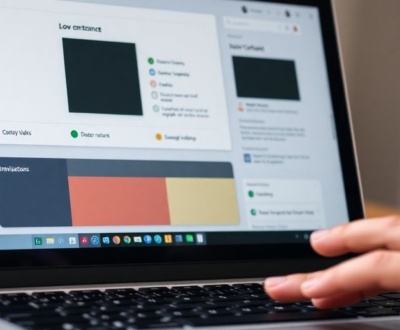Picking the right image format for your website can be a bit tricky. Two big players right now are WebP and AVIF. Both are pretty good at making image files smaller without losing too much quality. But they do some things differently. This article will help designers figure out which one to use and when, so your web graphics look great and load fast. We’ll look at how they work, what makes them different, and how they fit into a designer’s daily tasks, focusing on WebP vs AVIF for designers.
Key Takeaways
- AVIF often gives you smaller file sizes for high-quality images, like photos, because it uses really good compression. This means faster loading for visitors.
- WebP has been around longer and works on more web browsers. If you need something that shows up for almost everyone, WebP is usually a safer bet.
- For detailed pictures or images with lots of color changes, AVIF can keep the quality better. For simpler graphics, logos, or animated stuff, WebP is often a good choice.
- It’s a good idea to test your images in both formats. See how small you can make the file while still having the image look good. Every image is a little different.
- Sometimes, the best plan is to use both. You can set up your website to show AVIF to newer browsers and WebP to older ones. This way, everyone gets a good experience.
Understanding AVIF for Designers
AVIF is gaining traction, and for good reason. It’s built to give you better compression and image quality compared to older formats. But how does it actually fit into a designer’s workflow?
AVIF’s Advanced Compression Techniques
AVIF uses the AV1 video codec as its base, which means it’s packing some serious tech under the hood. The goal is to shrink file sizes without making your images look terrible. It achieves this through methods like intra-prediction, which looks at neighboring blocks of pixels to predict what a block should look like, and adaptive quantization, which changes the compression level based on how complex the image is. It’s all about being smart with how it compresses, so you get smaller files and retain more detail.
Color Depth and Fidelity in AVIF
One of the big wins with AVIF is its ability to handle a wider range of colors. It supports 10-bit and 12-bit color depths, which means more shades and smoother gradients. This is especially important for HDR content, where you need that extra color information to really make the image pop. Think about it: more accurate colors, more vibrant images, and fewer of those weird banding artifacts you sometimes see with JPEGs.
When to Prioritize AVIF for Design
So, when should you reach for AVIF? Here are a few scenarios:
- High-resolution photography: If you’re working with images that need to look their best, AVIF can deliver smaller file sizes without sacrificing detail.
- Images with gradients: AVIF’s color depth helps preserve smooth transitions, avoiding banding.
- Websites with lots of images: Smaller file sizes mean faster loading times, which is always a good thing.
AVIF isn’t a magic bullet. It requires more processing power to encode and decode, and browser support isn’t universal yet. But if you’re looking for the best possible image quality at the smallest file size, it’s definitely worth considering.
Exploring WebP for Designers
WebP, developed by Google, has become a popular choice for web designers looking to balance image quality and file size. It’s been around for a while now, and it’s a pretty solid option for a lot of different use cases. Let’s take a closer look at what WebP brings to the table.
WebP’s Versatile Compression Methods
WebP stands out because it supports both lossy and lossless compression. This gives designers flexibility depending on the image type and the desired level of compression. Lossy compression is great for photos where you can afford to lose a little bit of detail to get a smaller file size. Lossless is better for graphics and images where preserving every pixel is important. WebP achieves lossless compression by constructing new pixels from pre-existing images. But, if it can’t find an exciting match, it can use a local palette. This dual approach makes WebP a versatile tool in a designer’s arsenal. It’s not a one-size-fits-all solution, but it’s adaptable.
Transparency and Animation Support
One of WebP’s strengths is its support for transparency, similar to PNG, but often with smaller file sizes. This makes it ideal for logos, icons, and other graphics that need to overlay on different backgrounds. Plus, WebP supports animation, offering a more efficient alternative to GIFs. Think about using WebP for simple animations on your website – it can really cut down on file sizes compared to traditional GIFs. For graphics with transparency (like logos, icons, or images with text and flat colors), WebP often works beautifully.
Optimizing WebP for Speed
Smaller file sizes translate to faster loading times, which is crucial for user experience and SEO. WebP images generally load faster than JPEGs or PNGs, which can improve your website’s performance. When optimizing WebP images, consider adjusting the compression level to find the right balance between quality and file size. There are also various tools and plugins available that can automate the optimization process, making it easier to integrate WebP into your workflow.
Using WebP can significantly improve your website’s loading speed, leading to a better user experience and potentially higher search engine rankings. It’s a simple change that can have a big impact.
Key Differences in Image Compression
File Size Efficiency: WebP vs AVIF for Designers
When it comes to file size, AVIF generally wins. AVIF uses more advanced compression, often resulting in smaller files than WebP for similar image quality. This is largely thanks to its use of the AV1 video codec. Think of it like this: AVIF is like packing a suitcase with a vacuum sealer, while WebP is just neatly folding your clothes. You can fit more in the same space with AVIF. For example, tests have shown AVIF files can be significantly smaller, sometimes less than half the size of a WebP file for the same image.
Decoding Speed and Performance
While AVIF offers great compression, it comes at a cost. Decoding AVIF images can be more CPU-intensive than decoding WebP. This means that while WebP images may load faster due to lower CPU usage, AVIF saves more bytes but takes longer to load. It’s a trade-off between file size and processing power. On older devices, this difference might be noticeable, potentially causing slower page load times or a laggy experience. WebP’s decoding process requires more CPU power than simpler formats like GIF.
Lossy and Lossless Compression Options
Both AVIF and WebP support both lossy and lossless compression, giving you flexibility depending on your needs. Lossy compression reduces file size by discarding some image data, which can affect quality. Lossless compression, on the other hand, preserves all the original data, resulting in larger files but no quality loss. While AVIF is great for lossy compression, WebP sometimes edges it out in lossless scenarios. If you need the highest quality image with minimal data loss, especially for graphics without text, WebP might be the better choice. AVIF shines when you need maximum compression and can tolerate some quality loss, like with photos or images containing text.
Choosing between AVIF and WebP often comes down to balancing file size, image quality, and decoding speed. There’s no one-size-fits-all answer. Consider your specific use case and target audience to make the best decision.
Visual Quality and Detail Preservation

Handling Gradients and HDR Content
When it comes to gradients and HDR (High Dynamic Range) content, AVIF often shines. AVIF’s ability to handle higher bit depths (up to 10-12 bit color) means it can reproduce colors more accurately and reduce banding in gradients. This is a big deal if you’re working with images that have subtle color transitions or a wide range of brightness levels. WebP is no slouch, but AVIF generally provides a smoother, more faithful representation in these scenarios.
Sharpness and Fine Detail Retention
AVIF tends to retain fine details better than WebP, especially at lower file sizes. This is because of its advanced compression algorithms. If you’re dealing with images that have a lot of intricate details, like textures or fine lines, AVIF might be the better choice. WebP can sometimes struggle with these details, leading to a slightly softer or blurrier image. However, it’s not always a clear win for AVIF; WebP can sometimes preserve smooth gradients better, avoiding artifacts that AVIF might introduce.
Impact on Digital Art and Photography
For digital art and photography, the choice between AVIF and WebP can have a noticeable impact. AVIF’s superior color depth and detail retention make it a strong contender for high-quality images where accuracy is key. Think about detailed landscapes, portraits with subtle skin tones, or digital paintings with complex color palettes. However, the increased processing power needed for encoding and decoding AVIF can be a drawback. WebP, with its faster decoding, might be preferable for websites where speed is paramount, even if it means sacrificing a bit of visual fidelity.
Choosing between AVIF and WebP often comes down to balancing file size, visual quality, and processing power. There’s no one-size-fits-all answer; it depends on the specific image and the context in which it will be used.
Here’s a quick comparison table:
| Feature | AVIF | WebP |
|---|---|---|
| Color Depth | Superior (up to 12-bit) | Good |
| Detail Retention | Excellent | Good |
| Gradient Handling | Very Good | Good |
| HDR Support | Yes | Limited |
| Processing Power | Higher | Lower |
Browser Compatibility and Adoption
Current Support Landscape for AVIF
Okay, so let’s talk about where AVIF stands right now in terms of browser support. It’s not quite universal, but it’s getting there. Most modern browsers, especially the Chromium-based ones like Chrome, Edge, and Opera, have pretty good support for AVIF. Firefox is also on board. Safari has been a bit slower, but recent versions on macOS and iOS are starting to include support. The big thing to remember is that older browser versions might not play nice with AVIF, so you can’t just assume everyone will see your images.
WebP’s Widespread Browser Reach
WebP has been around for a while, which means it’s had time to become pretty much everywhere. You’ll find it supported across a huge range of browsers, including older versions that might still be in use. This wide compatibility is a big advantage for WebP. If you need to make sure your images show up for as many people as possible without any extra work, WebP is often the safer bet.
Future Trends in Image Format Support
Looking ahead, it’s pretty clear that AVIF is going to keep gaining ground. As more browsers update and older ones fade away, AVIF support will become more common. However, WebP isn’t going anywhere either. It’s a solid format, and it will likely remain a good option for a long time, especially when you need that broad compatibility. The key is to stay informed about browser updates and adjust your strategy as needed.
It’s a good idea to keep an eye on browser support stats. Sites like Can I Use are super helpful for checking which browsers support which features, including image formats. This way, you can make informed decisions about which format to use for your web graphics, and you can plan for fallbacks if necessary.
Strategic Choices for Web Graphics
Balancing Quality and File Size
Okay, so you’re staring at these images, right? You want them to look amazing, but you also don’t want your website to load slower than dial-up. It’s a classic balancing act. The trick is finding the sweet spot where the image looks good enough without being unnecessarily large. Think about it: does that tiny thumbnail really need to be a high-resolution masterpiece? Probably not. Tools that optimize web images can help you find that balance.
Considering Specific Use Cases
Not all images are created equal, and neither are their purposes. A product photo on an e-commerce site? That needs to be crisp and clear. A decorative image in the background? Maybe you can get away with a little more compression. Think about where the image is being used and what it needs to accomplish. Is it conveying critical information? Is it purely aesthetic? Tailor your format choice and compression settings accordingly. For example, if you have images with geometric shapes, consider using vector graphics instead of raster images.
Progressive Enhancement Strategies
Browser compatibility is still a thing, unfortunately. Not everyone is using the latest and greatest browser that supports all the fancy new image formats. So, what do you do? Progressive enhancement to the rescue! The idea is simple: serve the best possible image format to users who can handle it (like AVIF), but have a fallback in place (like WebP or even JPEG) for those on older browsers.
It’s like saying, "Hey, if you can appreciate the fine wine, here you go. If not, here’s a perfectly good beer." Everyone gets a drink, and nobody is left out. This approach ensures a good experience for everyone, regardless of their browser.
Here’s a simple breakdown:
- AVIF for modern browsers: Smaller file sizes, better quality. Win-win.
- WebP as a fallback: Good balance of compression and compatibility.
- JPEG for ancient browsers: Still widely supported, but use sparingly.
Workflow Integration for Designers

Software Compatibility Challenges
Okay, so you’re hyped about AVIF or WebP. Great! But does your software play nice? That’s the first hurdle. Not every design tool has jumped on the bandwagon yet. Photoshop’s support for AVIF, for example, used to be a pain, often needing plugins. Compatibility is improving, but it’s still something to check. Older versions of software might only support WebP, or neither. This can seriously slow down your workflow if you’re constantly converting files or switching between programs.
Adjusting Design Workflows
Integrating new image formats means tweaking how you do things. You can’t just save as JPEG and call it a day anymore. Think about these points:
- Batch Conversion: Learn how to batch convert images to WebP or AVIF. There are plenty of tools out there, like online converters or command-line utilities.
- Previewing: Make sure you can actually preview the images in your OS or image viewer. Some older systems might not support it natively.
- Version Control: Keep your original high-resolution files! You never know when you might need them again. Don’t just overwrite everything with WebP or AVIF.
It’s a good idea to create a separate folder for your optimized images. This keeps your original assets safe and makes it easier to manage different versions.
Testing and Optimization Practices
Don’t just blindly convert everything and hope for the best. Testing is key. Here’s what I do:
- Compare Visual Quality: Open the original image and the converted image side-by-side. Zoom in. Look for artifacts or loss of detail.
- Check File Sizes: Make sure the conversion is actually saving you space. Sometimes, with certain images, the difference might be negligible.
- Test on Different Devices: See how the images look on different screens and browsers. What looks good on your high-end monitor might look terrible on a mobile device.
Ultimately, the goal is to find the sweet spot where you’re getting the best possible visual quality with the smallest possible file size. This WordPress performance will take some experimentation, but it’s worth it in the long run.
Wrapping It Up: Picking Your Image Format
So, when it comes to picking between WebP and AVIF, there’s no single ‘right’ answer for everyone. It really just depends on what you need. If you’re all about getting the absolute best image quality and the smallest file sizes, especially for really detailed photos, AVIF is probably your best bet. But, if you need something that works everywhere, right now, WebP is super reliable because more browsers support it. A lot of folks are even using both, serving AVIF to newer browsers and WebP as a backup. The internet is always changing, and new image formats might pop up, but for now, WebP and AVIF are the top choices for making your website look good and load fast.
Frequently Asked Questions
What is AVIF?
AVIF is a newer image format that uses very smart ways to make pictures smaller without losing much quality. It’s based on a video technology called AV1. Think of it like packing a suitcase super tightly so you can fit more clothes, but they still look good when you unpack them.
What is WebP?
WebP is an image format made by Google. It’s been around longer than AVIF. It’s really good at making files small, and it can handle both regular pictures and pictures with clear parts (like a logo on a website) or even short animations. It’s like a Swiss Army knife for web images because it can do many things well.
Which format makes image files smaller, AVIF or WebP?
AVIF usually makes files much smaller than WebP for the same picture quality. This means websites can load faster, which is good for everyone. However, WebP images sometimes load a tiny bit quicker on your computer once they’re downloaded because they’re easier for your computer to ‘read’. So, AVIF saves more space, but WebP can be a bit faster to show up.
Which format offers better image quality?
For really detailed photos, especially those with lots of colors or smooth changes in light (like a sunset), AVIF often looks better. It keeps more of the fine details. WebP is great for most other web graphics, like drawings, logos, or pictures where you need clear backgrounds or movement.
Which format works on more web browsers?
WebP works on almost all web browsers today, so it’s a safe choice if you want everyone to see your images. AVIF is newer, so while many browsers support it now, some older ones might not. It’s a good idea to check if your audience uses browsers that support AVIF.
How do I choose between AVIF and WebP for my website?
If your main goal is the best possible picture quality with the smallest file size, especially for high-quality photos, go with AVIF. If you need images that work on almost every browser and are good for many types of web pictures, including those with clear parts or animations, WebP is a great choice. Sometimes, using both is best: show AVIF to newer browsers and WebP to older ones.
About this blog
We are a digital marketing company with a focus on helping our customers achieve great results across several key areas.
Request a free quote
We offer professional SEO services that help websites increase their organic search score drastically in order to compete for the highest rankings even when it comes to highly competitive keywords.









